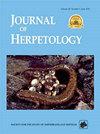入侵植物移除对陆生蝾螈负面影响的证据
IF 0.8
4区 生物学
Q3 ZOOLOGY
引用次数: 0
摘要
摘要入侵物种被广泛认为是对生物多样性的主要威胁。因此,控制入侵物种是土地管理者的常见做法。然而,入侵物种控制对非目标生物的影响往往是未知的。为了研究入侵植物移除对一组功能重要但经常被忽视的生物的影响,我们进行了一项以陆生蝾螈为重点的实地实验。使用盖板,我们监测了陆生蝾螈(主要是北拉维恩蝾螈、Plethodon electromophus)在实验性移除入侵植物的森林地块中的发生情况,而对照地块则没有进行移除。我们在三个研究地点复制了这一设计,并在3年内对盖板进行了采样(2016-2018;2187次采样事件)。我们还进行了一项实验室实验,将北方双线蝾螈(Eurycea bislineata)暴露于天然和入侵植物根提取物中,与平原水对照相比。占用建模和其他分析技术的结果表明,与对照组相比,在移除入侵植物的地块中,P.electromorpus的占用率大大降低。这种模式在研究地点之间各不相同,但在入侵最严重的地点最强。实验室暴露研究的结果显示,对天然植物和入侵植物的根提取物的反应没有显著差异。总之,这些数据表明,一些陆生蝾螈可能不会受到入侵植物的负面影响,而入侵植物的移除,如果没有本土植物的恢复,可能会对陆生蝾螈种群产生意想不到的负面影响。本文章由计算机程序翻译,如有差异,请以英文原文为准。
Evidence for Negative Impacts on Terrestrial Salamanders following Invasive Plant Removal
Abstract. Invasive species are widely believed to be a major threat to biodiversity. Therefore, invasive species control is a common practice among land managers. However, the impacts of invasive species control on nontarget organisms are often unknown. To examine the impact of invasive plant removal on a functionally important, but often overlooked, group of organisms, we carried out a field experiment focusing on terrestrial salamanders. Using coverboards, we monitored the occurrence of terrestrial salamanders (primarily Northern Ravine Salamanders, Plethodon electromorphus) in forest plots where invasive plants had been experimentally removed compared with control plots where removal did not occur. We replicated this design at three study sites and sampled coverboards over 3 yr (2016–2018; 2,187 sampling events). We also undertook a laboratory experiment exposing Northern Two-Lined Salamanders (Eurycea bislineata) to native and invasive plant root extracts compared with a plain water control. Results from occupancy modeling and other analytical techniques indicated strongly reduced occupancy of P. electromorphus in plots where invasive plants were removed, compared with controls. This pattern varied among study sites but was strongest at the most heavily invaded sites. Results from the laboratory exposure study showed no significant differences in response to root extracts from native versus invasive plants. Together, these data suggest that some terrestrial salamanders may not be negatively impacted by invasive plants and that invasive plant removal, when not accompanied by native plant restoration, may have unanticipated negative effects on terrestrial salamander populations.
求助全文
通过发布文献求助,成功后即可免费获取论文全文。
去求助
来源期刊

Journal of Herpetology
生物-动物学
CiteScore
1.60
自引率
0.00%
发文量
45
审稿时长
6 months
期刊介绍:
The Journal of Herpetology accepts manuscripts on all aspects on the biology of amphibians and reptiles including their behavior, conservation, ecology, morphology, physiology, and systematics, as well as herpetological education. We encourage authors to submit manuscripts that are data-driven and rigorous tests of hypotheses, or provide thorough descriptions of novel taxa (living or fossil). Topics may address theoretical issues in a thoughtful, quantitative way. Reviews and policy papers that provide new insight on the herpetological sciences are also welcome, but they must be more than simple literature reviews. These papers must have a central focus that propose a new argument for understanding a concept or a new approach for answering a question or solving a problem. Focus sections that combine papers on related topics are normally determined by the Editors. Publication in the Long-Term Perspectives section is by invitation only. Papers on captive breeding, new techniques or sampling methods, anecdotal or isolated natural history observations, geographic range extensions, and essays should be submitted to our sister journal, Herpetological Review.
 求助内容:
求助内容: 应助结果提醒方式:
应助结果提醒方式:


